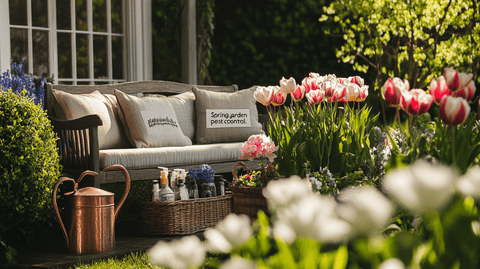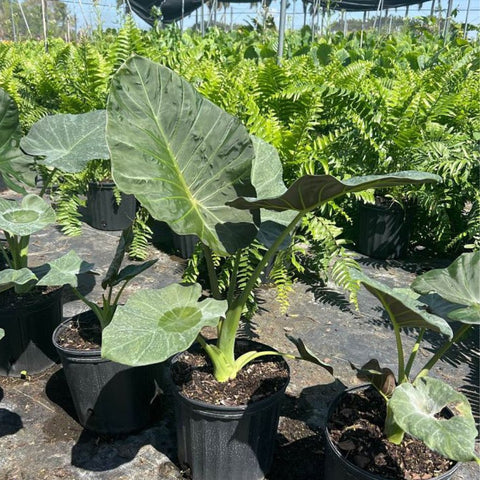Introduction
Picture this: it’s a crisp spring morning, and your garden, a dazzling display of colors and scents, is the envy of the neighborhood. But beneath that beauty, a silent battle is waging—it’s you against the pests that threaten to unravel your horticultural haven. As a gardener, you know that pest control is not just a task; it's an art. Keeping your garden beautiful and bountiful demands vigilance and strategy. This comprehensive guide from Plantology, your trusted online source for plants and trees, will equip you with the knowledge you need to maintain a pest-free spring garden.
Spring sets the stage for growth and renewal, and naturally, this season invites an array of pests. These uninvited guests can wreak havoc if left unaddressed, diminishing the health and aesthetics of your garden. But fear not! We’ll walk you through identifying common spring pests, understanding their behavior, and implementing effective prevention and control strategies, all while highlighting some useful additions from Plantology's robust selection.

Understanding Common Spring Garden Pests
Identification of Common Pests
Insects: Aphids, Slugs, Snails, Caterpillars
Insects are among the most frequent nuisances in spring gardens. Aphids, often found clustered on the tender parts of plants, are small insects that can quickly multiply. These pests siphon the sap from plants, which can cause wilting and even death if left untreated. Slugs and snails, with their soft, slimy bodies, are another menace, known for their appetite for leaves, especially in moist conditions typical of springtime.
Caterpillars, the larvae of butterflies and moths, may be beautiful as adults, but as they munch through leaves and flowers, they can leave a path of destruction in your carefully curated garden.
Rodents: Mice, Voles
While they might appear harmless, rodents like mice and voles can be a significant threat. These creatures tend to tunnel through garden beds, eating seeds, roots, and bulbs which can devastate your plantings. Signs of rodent activity include small holes around plants and gnawed roots.
Others: Fungi, Nematodes
Fungal pests, despite being less visible, can be even more problematic. Common fungal issues include powdery mildew and rust, which can quickly spread from leaf to leaf and plant to plant. Nematodes, microscopic worms that invade plant roots, can cause galls and stunt growth, impacting your garden’s vitality.

Life Cycle and Behavior
Seasonal Patterns and Habits
Pests generally emerge as temperatures rise and plants begin their spring growth. Understanding their life cycles can inform effective management strategies. Aphids, for instance, reproduce rapidly as the weather warms, making early detection critical. Meanwhile, slugs and snails prefer cool, damp conditions, commonly emerging after rainfall.
Impact on Garden Plants
The impact of pests varies but often results in stunted growth, blemished leaves, and reduced blooms or yields. This not only affects the immediate appearance but can also weaken plants, making them more susceptible to disease and environmental stressors.
Preventive Measures
Garden Hygiene
Good garden hygiene is your first line of defense against pests. Regularly clearing away dead leaves and plant debris removes potential breeding grounds. Implementing a mulching strategy can also prevent pest access to plant roots while retaining moisture and enriching the soil.
Companion Planting
Companion planting involves strategically placing certain plants together to naturally repel pests. For example, lavender and marigolds can deter aphids when planted alongside susceptible plants. Consider adding some Agapanthus Lily of the Nile for its pest-repelling properties and to enhance your garden's beauty.

Regular Monitoring
Regularly inspect your garden for early signs of pest activity. This enables you to take swift action before infestations become severe. Look for signs of nibbled leaves, sticky residue (often from aphids), or slime trails from slugs and snails.
Healthy Soil Practices
Maintaining healthy soil through proper pH levels, organic matter, and adequate drainage creates an environment that supports robust plant growth and deters pests. Conduct a soil test to understand your soil's nutrient levels and amend as necessary.
Organic Pest Control Methods
Natural Predators
Introduce or encourage natural predators of common garden pests. Ladybugs and lacewings, for instance, are voracious consumers of aphids. Birds, frogs, and toads can control slugs and snails effectively.
Homemade Solutions
Common household items can be used to create natural pest deterrents. A solution of dish soap and water can suffocate aphids, while coffee grounds or eggshells scattered around plants can deter slugs and snails.
Companion Plants
Planting pest-repelling species like basil, mint, or rosemary can naturally deter insects. They can be beautifully integrated into your garden design while also allowing you to enjoy their aromatic and culinary benefits.

Barriers and Traps
Physical barriers like copper tape can keep slugs at bay, while traps such as beer-filled containers can attract and drown these pests. Row covers can also protect young plants from insect attacks.
Chemical Pest Control
When to Consider Chemicals
In cases of severe infestations where organic methods may not suffice, chemical pest control can be considered. Always opt for environmentally sensitive products and follow application instructions carefully to minimize impact on beneficial fauna.
Choosing the Right Products
Select targeted pesticides over broad-spectrum ones to protect beneficial insects. Consider neem oil or insecticidal soap for less toxic options.
Application Tips
Apply pesticides during low wind conditions to prevent drift. Ensure that you're targeting the specific pest by applying directly to affected plants and avoid spraying in extreme temperatures to prevent plant damage.
Plantology's Recommendations for a Healthy Spring Garden
Beautiful and Resilient Plant Choices
Integrate resilient plant varieties that offer natural pest resistance. Explore our range of easy-care palms such as the Adonidia Palm (Single) that bring a tropical vibe while standing strong against pests.

For those looking for more options, our Agapanthus Lily of the Nile Blue selection not only adds striking hues to your garden but is known for its resilience and minimal pest issues.
Enhancements and Tools
Consider incorporating non-plant solutions such as planting beds and pest-proof netting to further protect your garden investments. At Plantology, we offer a range of products and accessories to aid you in creating the garden of your dreams. Visit our full selection at Plantology USA.
Conclusion
Successfully managing spring garden pests requires a blend of proactive monitoring, integrated pest management strategies, and careful product selection. Armed with the insights and resources from Plantology, you're well-equipped to cultivate a thriving, pest-free garden. Remember, a healthy garden is just a few well-chosen plants away, with the right pest control measures ensuring your plants reach their full potential.
Explore our comprehensive range of robust and attractive plants by visiting Plantology USA and transform your garden into a stunning, serene oasis, free from the tyranny of garden pests.
In-Depth Guide to Implementing Pest Control Strategies
Integrated Pest Management (IPM)
Integrated Pest Management (IPM) is a sustainable, eco-friendly approach that combines various pest control techniques and minimizes the use of chemical pesticides. This strategy is not only effective but also promotes a balanced ecosystem within your garden. IPM revolves around four key principles: prevention, monitoring, identification, and control.

Prevention
Prevention is the first and most crucial step in IPM. By creating unfavorable conditions for pests, you can significantly reduce the likelihood of infestations. This includes rotating crops to prevent the buildup of soil-borne pests, maintaining healthy soil through composting and organic fertilizers, and ensuring adequate spacing between plants to prevent overcrowding and reduce humidity levels.
Monitoring and Identification
Regular monitoring helps in early detection of pest problems before they become severe. Use sticky traps or regular visual inspections to track pest populations. Accurate identification is essential; understanding whether an insect is a pest, beneficial, or neutral will guide your control strategies. For instance, not all beetles are harmful, as some like the ladybug play a vital role in controlling aphid populations.
Control Methods
Once a pest problem is identified, choose control methods that are effective and minimally disruptive to the environment. Options include cultural controls like changing watering practices, mechanical controls such as hand-picking or vacuuming insects, biological controls that use natural predators or parasites, and chemical controls as a last resort.
Case Studies: Successful Pest Management Stories
Case Study 1: Natural Pest Control in a Home Vegetable Garden
Jane, an avid home gardener, faced recurring aphid infestations in her vegetable patch. She decided to adopt IPM principles by introducing a population of ladybugs to her garden. These natural predators significantly reduced the aphid population without needing chemical sprays. Additionally, Jane practiced companion planting, using garlic and chives alongside her lettuce to naturally deter pests. Over time, these practices not only led to a healthier garden but also enriched the local ecosystem.

Case Study 2: Slug Management in Flower Beds
Tom struggled with a persistent slug problem, especially with his hostas and marigolds. After research, he implemented both barriers and traps into his control plan. Using copper tape around his flower beds effectively kept slugs at bay, while beer traps attracted and eliminated those already present. This mechanical control method was complemented by the occasional manual removal, and together they created an effective pest management strategy.
Case Study 3: Combating Fungi Without Chemicals
In their organic farm, the Johnson family encountered powdery mildew on their squash plants. Committed to organic farming, they avoided synthetic fungicides. Instead, they resorted to creating a homemade solution using baking soda and water, which they applied weekly until the mildew was controlled. They also improved airflow around their plants by ensuring adequate spacing and pruning overgrown foliage.
Additional Advanced Pest Control Techniques
Soil Solarization
Soil solarization is an effective method especially for preparing garden beds before planting. It involves covering the soil with clear plastic to trap solar heat, which raises the soil temperature to levels that kill pests and pathogens.
This technique is particularly useful in dealing with nematodes and fungal diseases embedded in the soil. To solarize soil, moisten the area to be treated, cover it tightly with a clear plastic tarp, and leave it in place for 4-6 weeks during the sunniest part of the year.

Biopesticides and Organic Sprays
Biopesticides derived from natural materials are gaining popularity as they often target specific pests without harming beneficial insects. Products containing Bacillus thuringiensis (Bt) control caterpillar pests effectively without damaging other species. Neem oil, derived from the seeds of the neem tree, acts as an insect repellent and disrupts the development of pests at various stages of their life cycle.
Advanced Barriers
For larger gardens, consider installing insect netting or floating row covers to protect crops from insect damage, particularly during vulnerable stages like seedling growth. These physical barriers create a protective environment while allowing sunlight, water, and air to reach the plants.
Using Technology in Pest Management
Technology, such as smartphone apps, offers valuable assistance in pest identification and management. Various apps provide databases that help gardeners identify pest findings and offer environmentally friendly control solutions. Other technologies include sensors for monitoring pest populations and climate conditions, ensuring timely and precise interventions.
Creating a Balanced Ecosystem
Promoting Biodiversity
Diversifying plant species in your garden not only enhances aesthetic pleasure but also attracts a variety of wildlife, which maintains a natural balance. Encourage a range of beneficial insects by introducing flowering plants that provide nectar and pollen. The presence of bees, butterflies, and predatory insects like wasps helps in pollination and pest control.

Nurturing Soil Health
Healthy soil is the foundation of a thriving garden. Facilitate a robust ecosystem below ground by using organic matter like compost and cover crops, which enrich soil structure, retain moisture, and provide habitat for beneficial soil organisms.
Encouraging Wildlife
Welcoming wildlife isn't limited to insects. Birds, frogs, and hedgehogs are invaluable allies in pest control. Install birdhouses and provide water sources to attract these natural predators. Similarly, creating a small pond or marshy area can host amphibians beneficial for controlling pests like slugs and snails.
Conclusion: A Holistic Approach for a Bountiful Garden
Harnessing the power of nature through strategic pest management ensures not only a pest-free garden but also a flourishing one. By embracing the principles of integrated pest management, prioritizing prevention, and making informed choices about control methods, you create an environment where both plants and beneficial creatures coexist harmoniously. Your garden becomes more than a space for cultivation; it transforms into a vivid testament to the beauty and resilience of nature.
The key to a stunning garden is not just the plants but the ecosystem they thrive within. Each well-placed plant and predator contributes to a tapestry of life that keeps unwanted pests at bay. As you apply these management strategies and plant selections from Plantology USA, your garden will evolve into a vibrant oasis, resonating with the vibrant chorus of spring.

Engage with our community of gardening enthusiasts and share your own experiences of pest management by visiting Plantology Community. Together, let's cultivate gardens that not only stand out in beauty but are beacons of sustainable practices and ecological respect.






























Comments (0)
There are no comments for this article. Be the first one to leave a message!